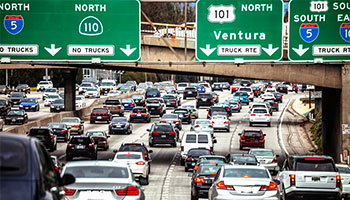Auto insurance is required in nearly every state, but that doesn’t always mean every motorist on the road carries the proper amount. As car insurance rates continue to increase, some drivers are deciding to opt out of car insurance entirely despite the legality of the choice. But what happens if you are the victim of a car accident with an uninsured driver? In these cases, uninsured/underinsured motorist coverage can help financially protect you. Let’s cover a few reasons why it is important to carry uninsured motorist coverage and why you may want to consider increasing your limits.
The Number of Uninsured Motorists in California

According to the Insurance Information Institute, approximately 17% of California drivers are uninsured. With around around 27 million licensed drivers in the state, this means there are some 4.5 million drivers on the road without the proper amount of insurance. What would happen if one of these drivers causes an accident and damages your vehicle? Depending on your insurance policy, you could be left to pay for repairs or medical expenses out of pocket.
Following an accident with an uninsured driver, you’ll need collision coverage to cover your vehicle’s repair or replacement costs. However, if you are seriously injured, your state-required liability insurance will not provide any coverage, nor will collision insurance. That’s because liability insurance only applies to damages you are responsible for, not your own injuries. In these circumstances, you’ll need uninsured motorists coverage (UM) to file a claim for your medical expenses, lost wages, or death. But what about health insurance? Although your health insurance can cover your medical expenses, it will not apply to any passengers in the car with you at the time of the accident.
What’s The Difference Between Uninsured and Underinsured Motorist Coverage?

When researching uninsured motorist insurance, you’ll likely encounter underinsured motorist insurance (UIM). In California, insurance companies are required to offer you this coverage. However, you can choose not to buy it after signing a waiver that says you were offered the coverage but turned it down. So, what’s the difference between the two? UM applies to accidents with a motorist who does not carry any form of insurance. However, UIM applies to accidents with a motorist who carries some form of insurance but not enough that is required or sufficient to cover damages they are responsible for.
If you’re involved in an accident with an uninsured driver, here’s how UM will provide coverage:
- Uninsured motorist bodily injury (UMBI): this coverage type pays for medical bills, lost wages due to injuries, and funeral expenses for you and any passengers that result from an accident with an uninsured motorist.
- Uninsured motorist property damage (UMPD): In California, UMPD will pay for the damage to your car from an accident with an uninsured driver if you do not have collision coverage. The limit is $3,500, but a payout will only apply if the uninsured driver is identified.
If you’re involved in an accident with an underinsured driver, here’s how UIM will provide coverage:
- Underinsured motorist bodily injury (UIMBI): UIMBI will provide coverage when a driver causes a car accident but does not carry enough insurance to cover your medical bills, lost wages, or funeral expenses for you and your passengers. In these circumstances, the driver’s insurance will cover the initial costs, and your UIMBI will cover the rest up to your policy’s limits.
- Underinsured motorist property damage (UIMPD): this will provide financial aid when a driver causes an accident but does not have enough coverage to cover your vehicle’s or property repair cost.
In most cases, your UM and UIM coverage limits will mirror your liability coverage limits. For example, if you carry liability limits of $50,000 per person and $100,000 per accident (50/100), you’ll also carry 50/100 in UM/UIM coverage.
How California’s Car Insurance Limits Will Increase in 2025
Despite its large population and number of drivers on the road, the Golden State is home to some of the country’s lowest minimum auto insurance requirements.

Since 1967, drivers in California have been required to carry liability insurance limits with minimums of 15/30/5, representing $15,000 for bodily injury per person, $30,000 for bodily injury per accident, and $5,000 for property damage per accident. Although the figures may sound plenty, a $5,000 limit won’t be much if your brand-new car is heavily damaged after an accident. This is why carrying additional coverage types, such as UM/UIM and collision coverage, is important.
California officials understand that the state’s low limit requirements can provide inadequate coverage, which is why they are set to change at the beginning of 2025. On January 1, 2025, Senate Bill 1107 will go into effect and amend California’s Vehicle Code to increase the state’s required auto insurance liability limits.
Under SB 1107, California’s current limits will be replaced with the following:
- $30,000 for bodily injury or death per person
- $60,000 for bodily injury or death per accident
- $15,000 for property damage per accident
These new limits will remain active for ten years until 2035 when they will increase again.
On January 1, 2035, California drivers will be required to carry the following liability limits:
- $50,000 for bodily injury or death per person
- $100,000 for bodily injury or death per accident
- $25,000 for property damage per accident
Although we understand that limits will increase, we can’t say for sure how everyone’s insurance premium will change, as multiple factors determine your rate. However, we’ve already seen a rise in insurance costs since last year, so consumers will likely face some form of higher rates after the new law goes into effect.
If someone does not currently carry insurance because it is too expensive, they’ll likely hold the same sentiment once the liability limits increase. Although this may not affect repair or medical costs, it could cause some drivers not to renew their policies. If this occurs, even more uninsured motorists will be on the roads. Uninsured/underinsured motorists coverage can provide a more significant safety net to protect yourself financially, especially if you don’t carry additional coverages such as comprehensive or collision insurance.
Speak With an AIS Insurance Specialist
At AIS, we understand that the insurance marketplace can sometimes be tricky. With so many carriers, coverages, and price points, shopping for auto insurance can at times feel overwhelming. However, it doesn’t have to be. At AIS, we have over 55 years of experience helping our customers navigate the insurance marketplace to find their ideal combination of coverage and price.
As we prepare for California’s limits to increase, consumers must begin their research now rather than later to avoid any major cost increases. Building good insurance habits, such as comparing quotes from multiple providers regularly, can help you ensure you get the best rate available. With over 6 million uninsured drivers on the road, you must protect yourself financially from a potential accident with someone who doesn’t carry insurance. If you’d like to learn more about California’s increasing limits or review your coverage options, our specialists can help. Call us today at (888) 772-4247, or visit us online to learn more.
The information in this article is obtained from various sources and offered for educational purposes only. Furthermore, it should not replace the advice of a qualified professional. The definitions, terms, and coverage in a given policy may be different than those suggested here. No warranty or appropriateness for a specific purpose is expressed or implied.


